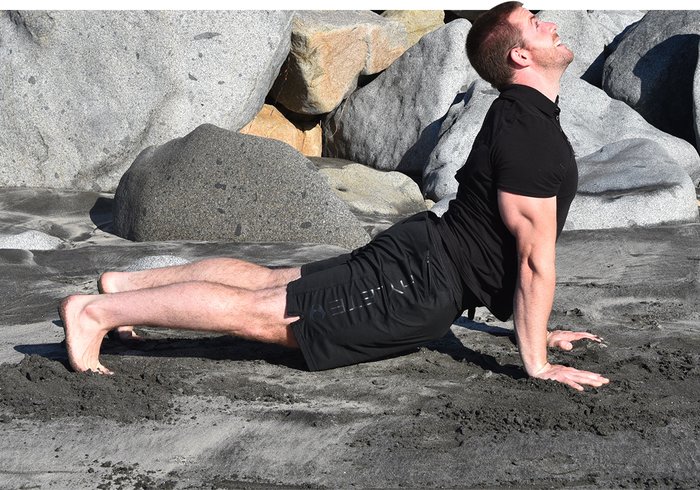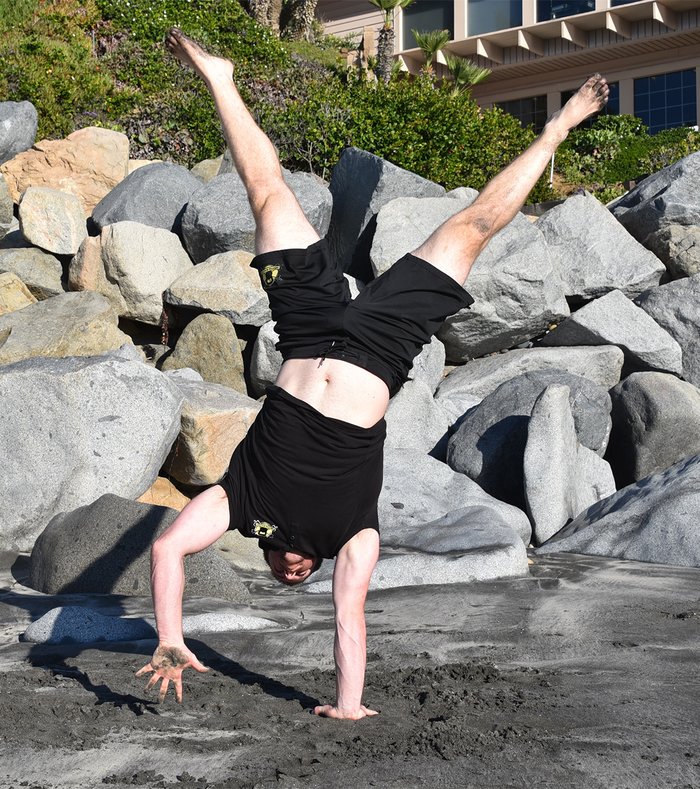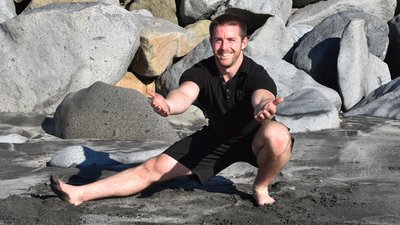Over the last year or so, trainer Max Shank has filled his YouTube and social media channels with a steady stream of strange, slightly sped-up videos. In each one, he is gliding more or less seamlessly between a wide variety of positions, usually in the dim light of post-sunrise. Weights? If they're there, they're only in the background.
Each of these "flows," as he calls them, is a mixture of the familiar and the exotic. There are some basic joint circles and head motions. Then there's something you recognize from yoga, and something else from a dynamic warm-up you once did. Each sequence is different, but what they share is a single length—5 minutes at normal speed. Not much time, right? Unless, of course, you do it every day, which is what Shank has done for over a year.
After just a few days and weeks, he says, he was amazed by how great he felt. After all, it was just movement, largely self-directed and intuitive. After doing it for a year, he's been amazed by how many times he's heard that his videos reached people from around the world, from elite athletes on down, and worked for them like nothing else had.
"I've written books and led countless courses, but the thing I've gotten the most positive feedback on in my career is the 5-Minute Flow," Shank wrote in an article on Bodybuilding.com. "All you do is move, in whatever way feels best, for 5 minutes each morning. Then you drink some water. That's it—and people tell me that it straight-up changed their lives.
Shank recently encapsulated his flow system into a book and video collection, The 5 Minute Flow Companion Guide, and he spoke with Bodybuilding.com to tell us how simple movement can make all the difference.
How did this idea come about?
Basically, I gave myself the task of helping people the most in the least amount of time. I mean, people already know that if you do push-ups and pull-ups, and squats, and stuff like that, you will get in better shape. The problem is that people don't do it.
Then, I took that understanding with the recurring theme from every book about success that I've ever read, which is something to the effect of, "You need a morning routine." Almost every successful person I've researched does some form of exercise in the morning.
Then, I learned about something called a "keystone habit." It's a habit you develop that makes you more likely to succeed with other habits. It has a domino effect that gives you willpower for whatever comes after. Seeing all this, I decided that my method for helping people live a better life was to have movement be the catalyst for that.
How do you keep it up?
After 10 years in the fitness industry, I've seen plenty of things fail to work. What I realize now is that sustainability requires two very specific pieces. First, don't get injured. Second, don't get bored. If you can avoid those, you basically win the game.
How do you do those two things? That's also a two-step process. Step one is to make sure your joints can handle load safely. That's joint mobility: Making sure you don't have ranges that you can't get to that will eventually hurt you. The way to avoid boredom is to be able to try new things all the time.

So now, this is my mission: To give people the physical freedom to pursue any athletic endeavor for the rest of their lives. Honestly, I don't know what you're going to like, whether it's stand-up paddleboarding, or gymnastics, or weightlifting, or whatever. To be honest, it doesn't matter, because your body will adapt to whatever you do with it, for better or for worse.
The key is to give yourself options so you always have something that you are looking forward to doing; something that you're just dying to go do.
The word "flow" is indelibly tied to yoga for a lot of people, which may make them think, "I'm going to suck at this." How does that person find their foothold?
The program itself starts with very basic joint mobilizations that anybody can do. Sometimes, all I suggest to someone is that they start by doing a couple of neck rotations in the morning. Even if you stop after that, it's fine, because that's still a win. Then, moving on from there, you can say, "Okay, if I want to do the shoulders tomorrow, I can." From there, it's very progressive.
Not sure where to start? Try these:
Upper body
- Shoulder: Circles, internal and external rotation
- Scapulae: Elevation and depression, protraction and retraction, circles
- Elbow: Circles
- Wrist: Flex and extend, ulnar and radial deviation, circles, figure 8's
- Fingers: Flexion and extension
Spine
- Neck: Flex and extend, rotate, lateral bend, glide forward and back
- Thoracic spine: Rotation, flex and extend, lateral bend, circles
- Lumbar spine: Circle: tilt to the side, rotate around in a circle
Lower Body
- Hip: Flex and extend, internal and external rotation, abduction and adduction, rainbows
- Knee Circles
- Ankle: Flex and extend, tilts, circles
- Toes: Move them together and apart in various combinations
Things like joint circles just seem too simple to work. Do they, and how?
Do you floss your teeth? Well, you should do the same thing with all your joints, because joints don't have a direct blood supply. You need to move them in order to keep them healthy. You need to gently stress all the joint surfaces. A circle will glide over the largest surface area of those joints, which will increase your mobility.
I've heard you say that this cuts down on the amount of time you need to warm up in the gym. What else does having a daily movement habit do?
One thing I've noticed is increased energy immediately afterward. I get emails where people say, "Oh, I'm doing the 5-Minute Flow. I don't even need coffee anymore." Or, "I'm doing 5-Minute Flow, and my back and knees don't hurt anymore."

The beauty of it is that I didn't tell them to do anything specific. The fact of the matter is that a lack of movement is so widespread that almost any movement is a huge step forward. When people are moving, they have more energy in the morning. I've found that I have procrastinated less, and even my breathing was better.
Actually, I talk a lot about how important breathing is in 5-Minute Flow. The average person is in a state of more or less constant low-grade stress. They hold their breath, or they breathe only through their mouth. They are breathing up into their neck and shoulders, and they're using the wrong muscles to breathe. That creates a lot of dysfunctions physically and mentally, because you're in an oxygen debt at all times. It's almost like you have this weird feeling of drowning constantly.
It's no coincidence that in most pain therapists' offices, the first thing they will do is prescribe breathing exercises. It's the safest way to start getting someone out of pain, and they don't have to move anything. That's why breathing is so neurologically powerful.
When somebody first starts out, what do you recommend they prioritize during that 5 minutes?
I recommend that they focus on the isolated joint movements first. I find that if you jump too quickly into some of the compound movements, like deep lunge, thoracic bridge, and tabletops, where you have a lot of joints working toward the same goal, people sometimes don't have full mobility in a joint. What that does is pisses off the neighbors.
By this I mean that if your wrist is really stiff, your elbow may compensate for it. If your thoracic spine is very stiff, your shoulder may compensate for it. It's very important that you lay a good foundation of moving all the joints independently, or isolating them, before you integrate them.
Is there a place for things like push-ups and bodyweight squats in here as well?
Absolutely. I usually prefer something like a Hindu push-up, where you're going from a downward dog to sweeping underneath into an upward dog, because it's the benefit of a push-up, plus it's also encouraging flexibility maintenance and improvement.
Now the bro question: How does this make you stronger or better at lifting?
It absolutely makes you stronger! First off, anytime you're doing a movement, you're working against gravity, and you are working against the antagonist muscle groups. That's both with and without weight. But if you find it difficult to reach your arms overhead, period, you are going to find it even more difficult to safely lift a weight overhead. That by itself is huge.
Also, when you have good mobility, you're much more likely to achieve what's called "joint centration." Joint centration is just a fancy way of saying that your joint is centered in the socket. This reduces the likelihood of any neural inhibition or injury due to joint misalignment.
Having healthy joints also makes the strength work you do easier and more beneficial. Think about it this way: When you wake up in the morning, you're all stiff and sore. You haven't moved for eight hours. So for many people, every step we take is like an old man. But if you do mobility work in the morning, every step you take afterward is basically rehab.
I learned in physical therapy that when you finish doing a rehabilitative exercise, in order to help lock in that new pathway, it's very useful to have people walk for about 20 or 30 seconds. That's a good way to lock in that new range of motion. Cool, right?
Imagine if the stakes were a little bit higher and you have to chase a deer and run away from a tiger in the same day. You're probably going to make sure before you leave the cave that your ankles, wrists, and legs are moving well.
People love to say, "Oh, a tiger doesn't need to limber up before he goes and hunts a deer." But he does, right? He just does it when he wakes up in the morning.
A tiger stretches all day. That's almost all they do. The life of a tiger is fucking shit up and stretching.
So contrast this to just stretching a couple of times a week while watching TV at night. What's the advantage of flipping your day?
It's so huge to start your day with a win, even if it's a little tiny one, like if you just move for 5 minutes and then drink a cup of water. You've shown through your actions that you appreciate the body you have.

